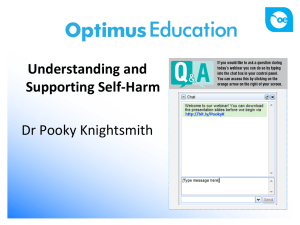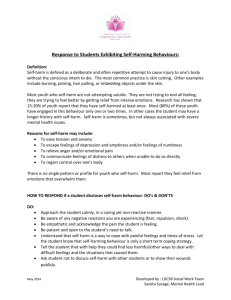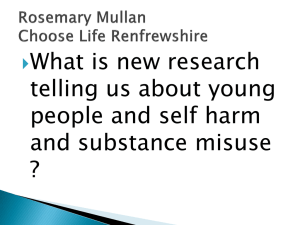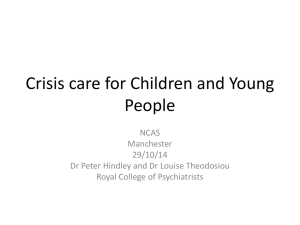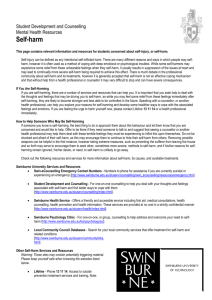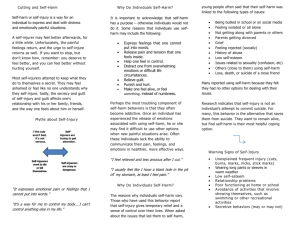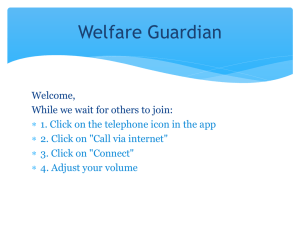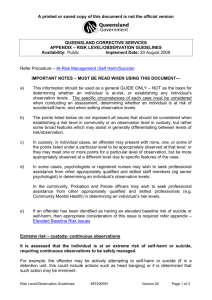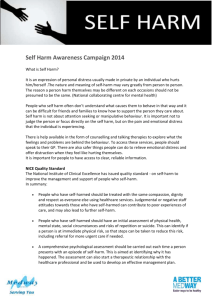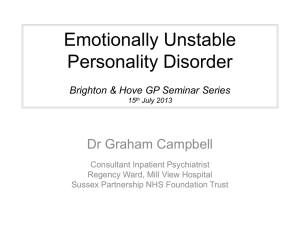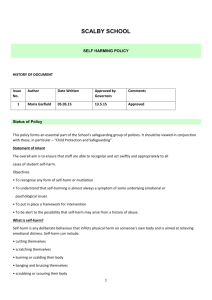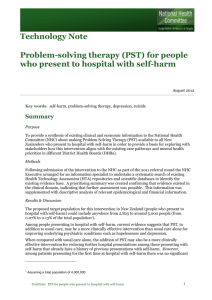Self-Harm Policy and Guidelines for School Staff
advertisement
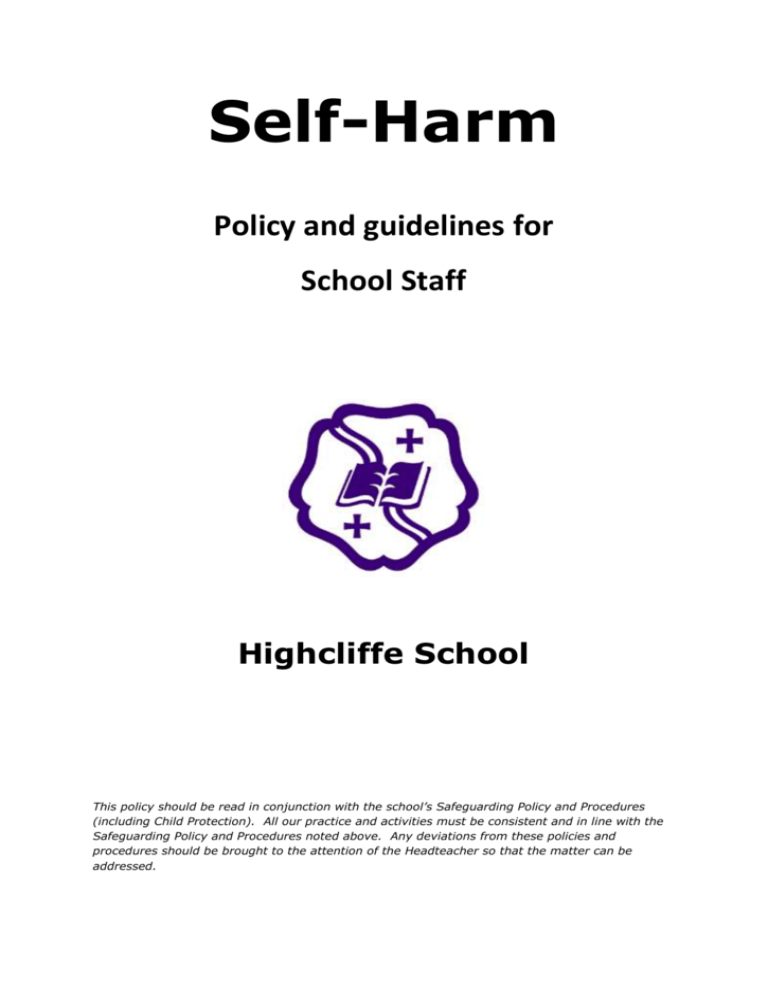
Self-Harm Policy and guidelines for School Staff Highcliffe School This policy should be read in conjunction with the school’s Safeguarding Policy and Procedures (including Child Protection). All our practice and activities must be consistent and in line with the Safeguarding Policy and Procedures noted above. Any deviations from these policies and procedures should be brought to the attention of the Headteacher so that the matter can be addressed. What is self-harm and how common is it? Self-harm is any behaviour such as self-cutting, swallowing objects, taking an overdose, running in front of a car or any act where the intent is to deliberately cause self-harm. Self-harm may imply suicidal tendencies; however, most instances of self-harm in young people are motivated by factors such as: a desire to escape an unbearable situation, intolerable or very strong emotional pain, a desire to reduce tension, to express hostility, to induce guilt or caring from others. Even if the intent is not suicidal the act of self-harming may express a powerful sense of despair and should be taken seriously. In December 2012 ChildLine announced a 68% increase during the year in the number of children contacting them about self-harm. This is the fastest rising cause of contacts to the charity. Younger children were also now much more likely to contact them about self-harm; amongst 14 year olds it was the leading concern What causes self-harm? The following risk factors, particularly in combination, may make a young person vulnerable to self-harm: Individual factors: Depression/anxiety Poor communication skills Low self-esteem Poor problem-solving skills Hopelessness Impulsivity Drug or alcohol abuse Family factors: Unreasonable expectations Neglect or abuse (physical, sexual or emotional) Child being Looked After Poor parental relationships and arguments Depression, deliberate self-harm or suicide in the family. Social factors: Difficulty in making relationships/loneliness Persistent bullying or peer rejections Wish to join peers in similar behaviours Easy availability of drugs, medication or other methods of selfharm. A number of factors may trigger self-harm: Family income related poverty Family relationship difficulties Difficulties with peer relationships Bullying Significant trauma e.g. bereavement, abuse Self-harm behaviour in other students (contagion effect) Self-harm portrayed or reported in the media Difficult times of the year, e.g. anniversaries Trouble in school, at home or with the police Feeling under pressure from families, school or peers to conform/achieve Exam pressure Times of change, e.g. parental separation/divorce Examples of self-harming behaviour: Cutting Taking an overdose Swallowing hazardous materials or substances Burning, physically or chemically Punching/hitting/bruising Banging of the head Hair-pulling/skin-picking Episodes of alcohol/drug abuse or over/undereating Risky sexual behaviour Self-harm can be transient behaviour in young people that is triggered by particular stresses and resolves itself fairly quickly, or it may be part of a longer-term pattern of behaviour that is associated with more serious emotional/psychiatric difficulties. Where a number of underlying risk factors are present, the risk of further self-harm is greater. Some young people get caught up in mild repetitive self-harm, such as scratching, which is often done in a peer group. In this case, it may be helpful to take a low-key approach, avoiding escalation, although at the same time being vigilant for signs of more serious self-harm. What keeps self-harm going? Once self-harm, particularly cutting, is established, it may be difficult to stop. Self-harm can have a number of functions for the student and it becomes a way of coping, for example: Reduction in tension (safety valve) Distraction from problems Form of escape Outlet for anger and rage Opportunity to feel real Way of punishing self Way of taking control To not feel numb To relieve emotional pain through physical pain Care-eliciting behaviour Means of getting identity with a peer group Non-verbal communication (e.g. of abusive situation) The cycle of self-harming/cutting When a person inflicts pain upon him- or herself, the body responds by producing endorphins, a natural pain-reliever that gives temporary relief or a feeling of peace. The addictive nature of this feeling can make stopping self-harm difficult. Young people who self-harm still feel pain, but some say the physical pain is easier to stand than the emotional/mental pain that led to the self-harm initially. Trigger event increases distress Self-harming takes place Relief from tension experienced Guilt or shame at self-harm Disgust about self and tension build-up Trigger event increases distress etc. Coping strategies Replacing the cutting or other self-harm with other safer activities can be a positive way of coping with the tension. What works depends on the reasons behind the self-harm. Activities that involve the emotions intensively can be helpful. Examples of ways of coping include: Using a creative outlet e.g. writing poetry & songs, drawing and talking about feelings Writing a letter expressing feelings, which need not be sent Contacting a friend or family member Ringing a helpline Using stress-management techniques such as relaxation Getting out of the house and going to a public place e.g. a shopping centre or a cinema Going for a walk/run or other forms of physical exercise Reading a book Having a shower Looking after an animal Joining a group activity: youth club, keep-fit class or a schoolbased club Regular counselling/therapy may be helpful For some young people, self-harm expresses the strong desire to escape from conflict or unhappiness. In the longer term, the young person may need to develop ways of understanding and dealing with the underlying emotions and conflicts. How to help: The role of school staff Please note that this guidance should be considered alongside the School Child Protection policy. Conversations with the young person Check your own feelings first: if you express shock, disgust or other non-positive emotions then you will communicate them to the young person See the person, not the problem. Talk in a genuine and empathetic manner. Talk to them in the same way as you would like to be addressed yourself. Use the ‘TED’ procedure: Tell, Explain, Describe. Young people will value a person who listens to them and does not judge. Confidentiality is a key concern for young people and they need to know that you cannot offer this. If the young person is selfharming then it is highly likely that you will need to inform someone (see the protocol at the end of this document). Resist the temptation to tell the young person not to do it again, or to promise you that they won’t do it. All mention of suicidal thoughts and deliberate self-harm should be listened to and taken seriously. In the case of you finding a young person who has self-harmed e.g. by overdosing or self-cutting, try to keep calm, give reassurance and follow the school’s normal first-aid guidelines: inform or take to the medical room, and in the case of any overdose of tablets a medical practitioner’s advice must be sought. Take a non-judgemental attitude towards the young person. Try to reassure the young person that the self-harm is helping him or her to cope, and that you also want to help them. Discuss with the young person whether his or her parents/carers are aware of the self-harm and the importance of letting them know. Talk to other colleagues and senior staff about your involvement – this may help you in dealing with any potential upset or anxiety that you have yourself about the incident of self-harming. Group support is not normally advisable in the case of contagion within a year-group or a school. Each young person will have a different reason for self-harming and they are therefore best supported in an individual manner. Protocol for dealing with self-harm: 1. All incidents of self-harm should be reported on a ‘Cause for Concern’ form to the designated person for child protection or their deputy. 2. Seek medical assistance from the medical room where First Aid will be applied if necessary. 3. Depending on the severity of the injuries or overdoses it may be necessary to call an ambulance or to take the young person to Accident and Emergency. 4. Young people who have taken overdoses should always attend Accident and Emergency, or be attended by an ambulance crew. 5. Contact should be made with parents/carers by the most appropriate member of staff. 6. Parents/carers should be advised of possible routes of support for the young person: the child’s GP, the School Nurse, a referral to Dorset or Hampshire CAMHS(Child and Adolescent Mental Health Service), ELSA (Emotional Literacy) support in school, general mentoring and monitoring. 7. To help parents, they may find reference to the following websites useful: www.childline.org.uk; www.youngminds.org.uk In each case type ‘selfharm’ into the search box for the necessary advice and guidance. Depending on the nature and the severity of the self-harm some of the following measures should be taken: Continue to monitor the self-harm through a member of staff whom the young person trusts and with whom they have been able to build a relationship. Provide the young person with guidance and contacts (see 7). If you are concerned about the young person’s mental health, consult with CAMHS about a possible referral. Discuss with the young person, their parents, their Head of Achievement, Head of School and any other adults and agencies who have a role in the young person’s life to identify a plan to support them. Consider making an ISP (Individual Support Plan) if appropriate. Discuss the need for a pre-CAF (Common Assessment Form) with the locality team to engage multi-agency support. If you identify child protection concerns, follow school procedures in the normal manner. Document any conversations that you have regarding the young person either on student-log, or a Cause for Concern form. Compiled by: N Campbell Agreed by: Revision number: P Earnshaw Headteacher Adopted by: Governing Body Revision date: Summer 2016 Contacts for help, advice and support: The family doctor The school nurse Young Minds Parents Information Service 0800 018 2138 Childline www.childline.org.uk Young Minds www.youngminds.org.uk Samaritans 08457 90 90 90 www.samaritans.org
